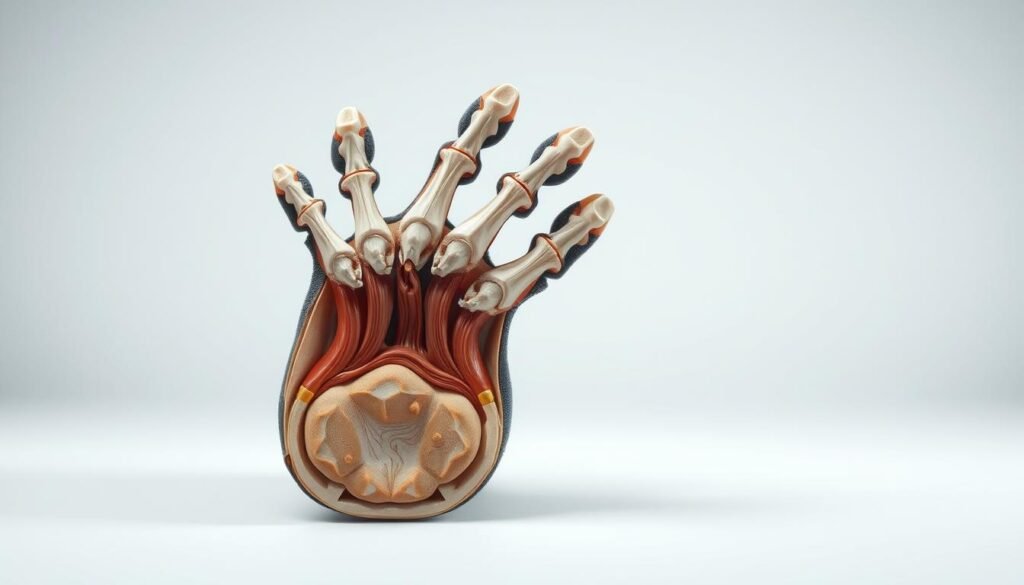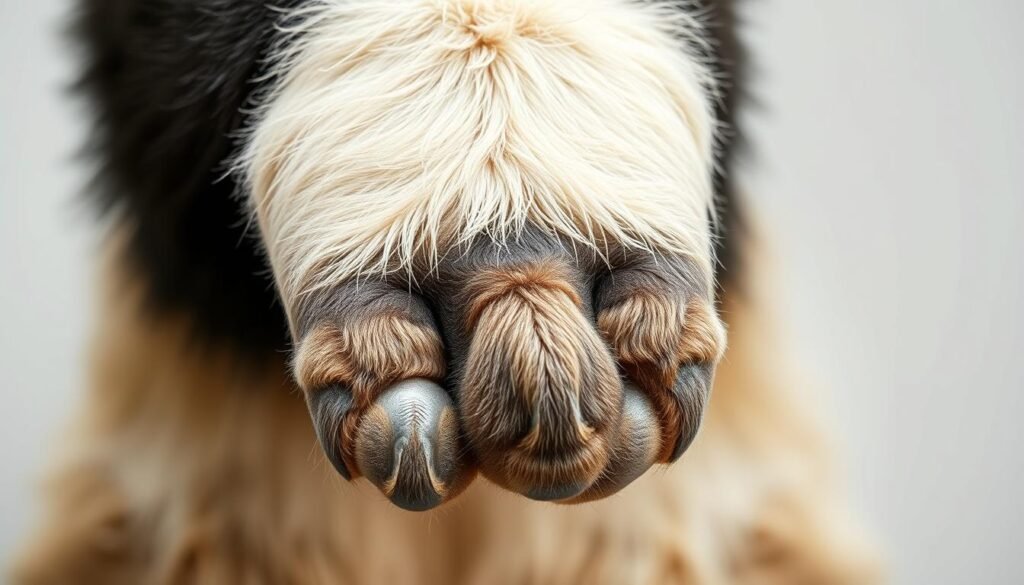Why Do Pandas Have a Pseudo-Thumb for Grasping? Pandas have a special wrist bone that acts like a thumb. This pseudo-thumb lets them hold bamboo stalks very well. It’s a key part of their diet.
Their grasping mechanism shows how pandas have adapted over time. This special bone helps them grab bamboo easily. It’s vital for their survival.
Learning about the panda’s anatomy and evolution is fascinating. It shows how their unique thumb helps them eat and survive.
Contents
- 1 The Unique Anatomy of Panda Bears
- 2 Why Do Pandas Have a Pseudo-Thumb for Grasping?
- 3 The Evolutionary Development of the Pseudo-Thumb
- 4 Anatomical Structure of the Panda’s Pseudo-Thumb
- 5 Comparing Panda Adaptations to Other Species
- 6 Conclusion: Why Do Pandas Have a Pseudo-Thumb for Grasping?
- 7 FAQ
- 7.1 What is a pseudo-thumb?
- 7.2 Why do pandas need a pseudo-thumb to eat bamboo?
- 7.3 How does the panda’s pseudo-thumb compare to a true opposable thumb?
- 7.4 Are there other animals that have similar adaptations to the panda’s pseudo-thumb?
- 7.5 What is the significance of the panda’s pseudo-thumb in their evolutionary history?
- 7.6 Can the panda’s pseudo-thumb be used for purposes other than feeding?
- 7.7 How does the anatomy of the panda’s pseudo-thumb contribute to their grasping ability?
The Unique Anatomy of Panda Bears
Panda bears have some amazing features that make them stand out. Their black and white fur is one of the most famous. It helps them blend in with their surroundings.
Black and White Coloration
The black and white fur of pandas is perfect for hiding. The white fur matches the snow, and the black fur hides in shadows. This coloration is key to their survival.
Pandas are big and strong, weighing 150-250 pounds. Their size helps them eat a lot of bamboo. This diet is almost all they eat. [Why Do Pandas Have a Pseudo-Thumb for Grasping?]
| Characteristic | Description |
|---|---|
| Body Length | 4-6 feet |
| Weight | 150-250 pounds |
| Diet | Primarily bamboo |
Historical Scientific Observations
Scientists have always been curious about pandas. They noticed their unique fur and strong bodies. This sparked a lot of interest in their evolution. [Why Do Pandas Have a Pseudo-Thumb for Grasping?]
Initial Misconceptions
At first, people thought pandas were related to other bears or raccoons. But, studies have shown they are truly unique. They belong to their own special group in the Ursidae family.
Learning about panda anatomy helps us understand them better. Their special features show how well they adapt to their environment. [Why Do Pandas Have a Pseudo-Thumb for Grasping?]
Why Do Pandas Have a Pseudo-Thumb for Grasping?
Pandas have a special pseudo-thumb that helps them survive. Their diet is almost all bamboo, which is hard to hold because it’s smooth and slippery. The pseudo-thumb lets pandas grip bamboo stalks securely.
Bamboo is tough to eat because it’s not very nutritious and has a lot of fiber. Pandas need to eat a lot to get enough nutrients. Their pseudo-thumb is key for grasping and moving bamboo.
Feeding Efficiency Requirements
Pandas spend a lot of time eating. Their pseudo-thumb helps them hold bamboo stalks tightly. This saves energy, which is important for eating bamboo. [Why Do Pandas Have a Pseudo-Thumb for Grasping?]
Bamboo Manipulation Techniques
Pandas use their pseudo-thumb in many ways. They can hold stalks, pull off leaves, and even break bamboo. This skill is vital for eating bamboo efficiently.
Other Uses Beyond Feeding
The pseudo-thumb is not just for eating. Pandas also use it to climb, defend themselves, and explore their surroundings. This shows how important the pseudo-thumb is in a panda’s life.
In summary, the panda’s pseudo-thumb is a remarkable feature. It helps them eat bamboo efficiently and survive. This adaptation is crucial for pandas.
The Evolutionary Development of the Pseudo-Thumb
Exploring the panda’s unique thumb reveals a complex history. The pseudo-thumb, a key adaptation for bamboo, is the result of millions of years of evolution. It’s not just a simple feature but a result of strong evolutionary pressures.
The diet of ancient bears is key to understanding the panda’s pseudo-thumb. These bears were once omnivores, eating fruits, insects, and small animals. Their diet was diverse, leading to generalist physical adaptations.
Transition to Bamboo Specialization
Over time, some bears became bamboo specialists. This change required the pseudo-thumb for efficient bamboo handling. The shift to bamboo was likely due to environmental pressures and food availability.
Fossil Evidence
Fossils reveal the panda’s pseudo-thumb evolution. Early fossils show less developed pseudo-thumbs. This evolution shows the pseudo-thumb’s crucial role in the panda’s survival.
Genetic Studies
Genetic studies shed light on the pseudo-thumb’s development. Research found specific genes linked to its formation. This shows how genetics and environment interact in the panda’s adaptations.
The panda’s pseudo-thumb is a marvel of nature’s adaptability. It emerged through diet specialization, environmental pressures, and genetics. This unique feature is vital for the panda’s survival.
Anatomical Structure of the Panda’s Pseudo-Thumb
To understand the panda’s pseudo-thumb, we must look at its anatomy. It’s not a real thumb but an adaptation for grasping bamboo. This is key for pandas to eat their main food. [Why Do Pandas Have a Pseudo-Thumb for Grasping?]

The pseudo-thumb is made of a sesamoid bone in the tendon of the flexor pollicis longus muscle. This bone is vital for the pseudo-thumb’s function. It gives the needed flexibility and strength to hold bamboo stalks.
Comparison to True Opposable Thumbs
The panda’s pseudo-thumb is different from true opposable thumbs in primates. It’s a modified radial bone that sticks out from the wrist. This lets pandas grip things. This unique feature shows how pandas have evolved.
| Characteristics | Panda’s Pseudo-Thumb | True Opposable Thumb |
|---|---|---|
| Structure | Sesamoid bone embedded in tendon | Fully formed opposable digit |
| Functionality | Gripping bamboo stalks | Manipulating a variety of objects |
| Opposability | Not fully opposable | Fully opposable |
Radial Sesamoid Development
The radial sesamoid bone’s development is crucial for the panda’s pseudo-thumb. Research shows it comes from genetics and environment. This shows how nature and nurture work together.
Associated Muscles and Tendons
The pseudo-thumb is supported by muscles and tendons. The flexor pollicis longus muscle and its tendon are key. They help pandas grip bamboo. [Why Do Pandas Have a Pseudo-Thumb for Grasping?]
Understanding the panda’s pseudo-thumb shows how they adapt to their environment. It’s fascinating to see how their anatomy helps them survive.
Comparing Panda Adaptations to Other Species
Looking at how pandas adapt compared to other animals shows us a lot about evolution. It’s interesting to see how many species have special traits to live in their environments.
Definition and Examples
Adaptations are special features that help animals survive and thrive. For example, pandas have a pseudo-thumb that lets them hold onto bamboo stalks. Other animals, like primates, have flexible hands and feet for climbing.
Evolutionary Pressure Similarities
Many animals face similar evolutionary pressures, such as finding food or avoiding predators. The adaptations that come from these pressures can be surprisingly similar across different species. For instance, both pandas and red pandas have special wrist bones to grasp their main food sources.
Red pandas also have a pseudo-thumb for eating bamboo. But their diet and habitat are different from giant pandas. This shows how different species can find similar solutions to common problems.
Primates and Other Mammals
Primates and other mammals have unique adaptations too. Some primates have strong arms for swinging, while others have complex social behaviors to protect their groups. These adaptations show the wide range of ways animals can adapt to their environments.
Conclusion: Why Do Pandas Have a Pseudo-Thumb for Grasping?
You now know how the panda’s pseudo-thumb works. It’s a special feature that lets pandas hold and move bamboo stalks easily. This is key for their survival, as bamboo is their main food.
The pseudo-thumb shows how amazing life on Earth can be. It proves that evolution can lead to incredible solutions. This is a sign of nature’s endless creativity and adaptability.
Thinking about the panda’s special way of grasping makes us appreciate these animals more. It also highlights the need to protect them. The panda’s pseudo-thumb is a true marvel of evolution. It keeps inspiring scientists and animal lovers everywhere.
See Also: Why Turtles Retract Heads Into Shells for Defense?
FAQ
What is a pseudo-thumb?
A pseudo-thumb is a modified bone that acts like a thumb. It helps pandas grasp bamboo stalks. [Why Do Pandas Have a Pseudo-Thumb for Grasping?]
Why do pandas need a pseudo-thumb to eat bamboo?
Pandas need a pseudo-thumb to hold bamboo stalks. This is because bamboo is their main food, and it’s hard to eat.
How does the panda’s pseudo-thumb compare to a true opposable thumb?
The panda’s pseudo-thumb is not a true opposable thumb. It’s a modified bone that helps pandas grasp bamboo.
Are there other animals that have similar adaptations to the panda’s pseudo-thumb?
Yes, animals like red pandas and some primates have similar adaptations. These help them grasp and manipulate food or objects.
What is the significance of the panda’s pseudo-thumb in their evolutionary history?
The panda’s pseudo-thumb is key to their survival on bamboo. It shows their evolutionary history and specialization.
Can the panda’s pseudo-thumb be used for purposes other than feeding?
Yes, the panda’s pseudo-thumb is versatile. It helps with climbing and manipulating objects too. [Why Do Pandas Have a Pseudo-Thumb for Grasping?]
How does the anatomy of the panda’s pseudo-thumb contribute to their grasping ability?
The panda’s pseudo-thumb anatomy is designed for grasping. It includes a sesamoid bone and muscles. This lets pandas hold bamboo stalks well.

Zyair Larson, based in Denver, Colorado, has over 12 years of experience studying animal behavior. He has worked with the World Wildlife Fund (WWF) and National Geographic, researching wildlife and sharing insights on animal habits globally.

